The CyberPower ValuePro VP1600ELCD 1600 VA UPS Review: A Solid Budget Power Backup
by E. Fylladitakis on October 28, 2022 6:00 AM EST- Posted in
- Cases/Cooling/PSUs
- CyberPowerPC
- UPS
- CyberPower
Testing
The basic electrical figures of the CyberPower ValuePro VP1600ELCD 1600 VA UPS are quite good – unexpectedly so, in fact. The transfer times are exceptional, with the unit requiring less than 4 ms to switch while fully loaded. The RMS voltage and frequency output look to be extremely close to the expected 230V/50Hz output. There are minor frequency variations but these are exceptionally small.
| UPS Load Performance | |||||
| 10% | 25% | 50% | 75% | 100% | |
| Voltage Output (Vrms) | 230 | 230 | 230 | 230 | 229 |
| Frequency (Hz) | 50 | 50 | 50.05 | 50.05 | 49.95 |
| Transfer Time (ms) | 1.6 | 2.2 | 2.6 | 3.4 | 3.9 |
Our load testing reveals that CyberPower’s running charts are quite accurate. The runtime is well over two hours with a load of 50 Watts, a little over 10 minutes with a load of 500 Watts, and slightly less than 2 minutes with the UPS fully loaded. In theory, the UPS can hold a lightly loaded typical PC for over than half an hour. These times are great considering the UPS also lacks any active cooling. These figures are achieved with the batteries fully charged while they are still brand new.
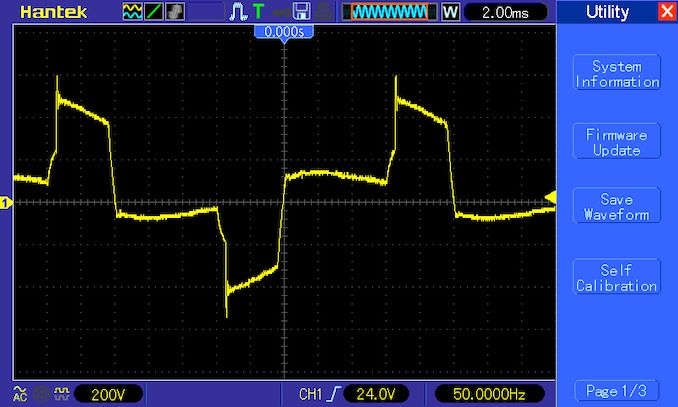 Battery Output Waveform - 5% load
Battery Output Waveform - 5% load
The CyberPower ValuePro VP1600ELCD 1600 VA is a unit with a “modified sine wave” output. What that means is that the output will not be close to the standard sine wave that we receive from grid, but an approximation of it. This approximation typically is a ladder wave with a few steps. The better the circuitry design, the more the steps, thus the better the approximation to a true sine wave output. Depending on the manufacturer and cost of the product, designers will make the corresponding effort to simulate a true sine wave as much as possible.
As expected from a UPS at this price point and with such a high power output, the output quality while on battery backup is quite poor. It does not even resemble a sinewave – it is but a two-step square wave that ultimately produces a 230 V RMS output. There is a momentary peak at the front of the second step, which is extremely high but also very short. The peak-to-peak voltage of this waveform is over 1000 V due to these peaks but they are too short to cause any kind of damage.
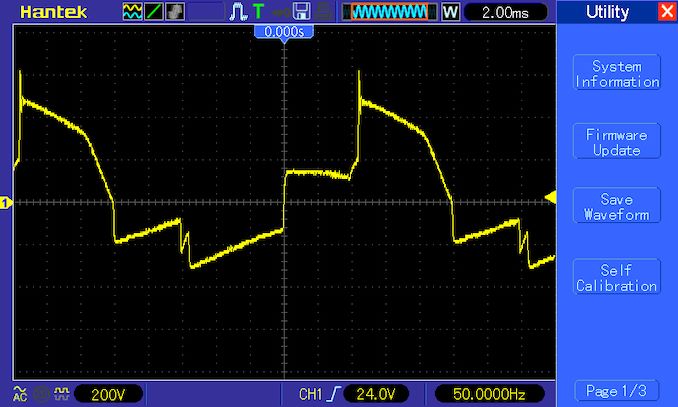

Battery Output Waveform - 50% load (left) / 100% load (right)
As is the case with such designs, the circuitry of the CyberPower ValuePro VP1600ELCD 1600 VA adjusts the timing of the MOSFETS to maintain a stable output. The output waveform shifts greatly as the load increases but it basically always remains a two-step square wave. The RMS voltage value of the output always remains stable at 230V.
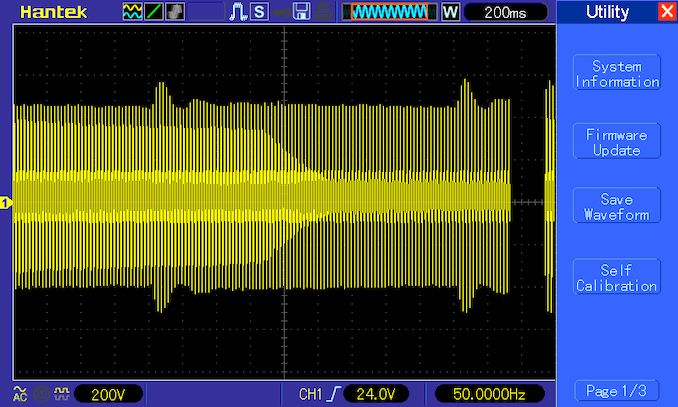
Battery Output Waveform - 20% load, 3 second period
One undesirable effect we noticed regarding the output of the CyberPower ValuePro VP1600ELCD 1600 VA is that the output is not perfectly stable over time. Every 1.5 second or so, the output voltage is slightly boosted, reaching up to nearly 1200V peak-to-peak for less than 100ms. It does not really affect the RMS output of the unit over time but the instability of the timing circuitry on a brand-new unit is peculiar.
Once turned off, there is no voltage on any of the outputs of the UPS. The parasitic power draw of the UPS when the batteries are charged is extremely small, at less than 1.5 Watts when the LCD is also turned off.
The Software
CyberPower supplies the PowerPanel Personal software package for free. It is a simple but functional software package that can adjust the basic functions of the UPS and logs its events. Note that the Personal version of the software is PC-based and will only record events locally. For example, if installed on a new computer, the number of events will be zero regardless of how much time the UPS has previously been in use. Those that would like to keep track of events across multiple systems and/or after system upgrades, CyberPower offers paid cloud-based solutions.
The software performs quite well for event recording - as long as the system is powered on. It records the number and the length of all electrical faults and also monitors the AVR. It also calculates and displays the energy consumption of the UPS and its connected devices across a user-defined time period. Users may also enter their region and the kWh price for the UPS to calculate the monetary cost and estimated CO2 emissions of the energy used.
Weekly timing schedules can also be programmed into the UPS, allowing the powering of equipment only for a certain time period every day. This option can be an effective energy-saving measure for workspaces and areas where the connected equipment is supposed to operate only within a certain range of hours every week.
The software supports local notifications of faults, but it can also be set to send an email on major events. Users can also disable the audible alarms of the UPS itself – a handy feature for homes, especially shared and/or family homes. Finally, users can adjust the AVR threshold limits. It is worthwhile to mention that the narrowest limits are greater than ±25% of the expected 230V output, so this is not a device that can help regulate the voltages going in to very sensitive equipment.
Conclusion
CyberPower has a very wide range of products, all meant for different needs. The ValuePro VP1600ELCD 1600 VA UPS (or CP1500AVRLCD for the 120V markets) is an effort by CyberPower to provide a very cost-effective but powerful solution for homes and small businesses.
In terms of quality, the CyberPower ValuePro VP1600ELCD 1600 VA is better than what we would expect from a product of this price range. The design is simplistic and greatly outdated, but the components used are of above-average quality, ensuring long-term reliability. However, its AC output while running on batteries is very poor and will greatly stress modern electronics, generating harmful harmonics in the process. Modern equipment has measures against this and will tolerate it for short periods of time but prolonged/frequent use would not be a good idea.
One very important characteristic of this UPS is its cooling, or, to be percise, the lack of it. It is a very rare sight for a UPS with this kind of power output, even more so for models that feature an AVR. The side effect of this design choice is that CyberPower’s engineers, rightfully, had to broaden the limits where AVR kicks in by a lot. This it to prevent AVR from interfering unless it absolutely has to, otherwise the unit would overheat. It can handle the stock battery runtime but does heat up a lot if needed to run on batteries for more than a few minutes. This means that the UPS is essentially running at the upper limit of its design capabilities; building the unit with a higher capacity battery (or upgrading/expanding the stock battery) is all but impossible, as anything more would lead to the transformer heating up so much that it would literally melt through the plastic body.
Otherwise, given the lack of a fan, the UPS will always be completely quiet while powered by an AC outlet, and only a subtle humming noise will be audible while it is running on battery power (aside from its alarm beeper of course if it is not disabled). The humming noise is due to the electromechanical vibrations of the transformer, which are caused by the very poor AC waveform generated by the inverter. If theoretically this unit could generate a true sinewave output, it would always be completely inaudible.
On paper, everything about this UPS series seems positive. It has a peak power output of nearly 1000 Watts, it is completely silent, the AVR does not require switching to battery power, the battery runtime is fair, it comes from an established manufacturer, and retails for less than €199/$185. However, there are practical limitations. The power output, while it is running on batteries, is poor and definitely not good for sensitive electronics and devices. That, combined with the lack of any active cooling, immediately suggests that this UPS is meant to combat the occasional electrical fault and short brownouts. For home and office users in areas where the electrical grid is generally stable, it is an exceptionally cost-effective choice. Just keep in mind that it is not a product designed for areas where electrical faults are frequent and significant, or where very sensitive/critical equipment needs to be protected.


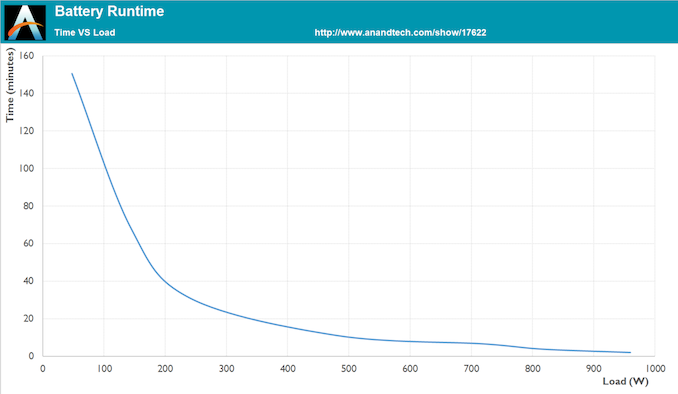







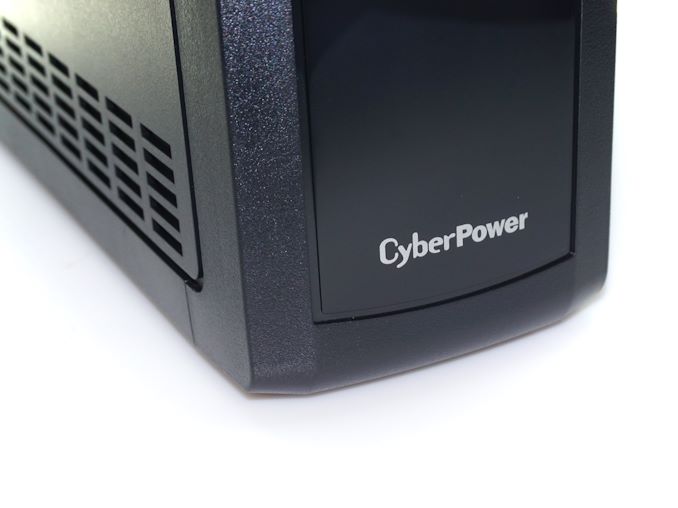
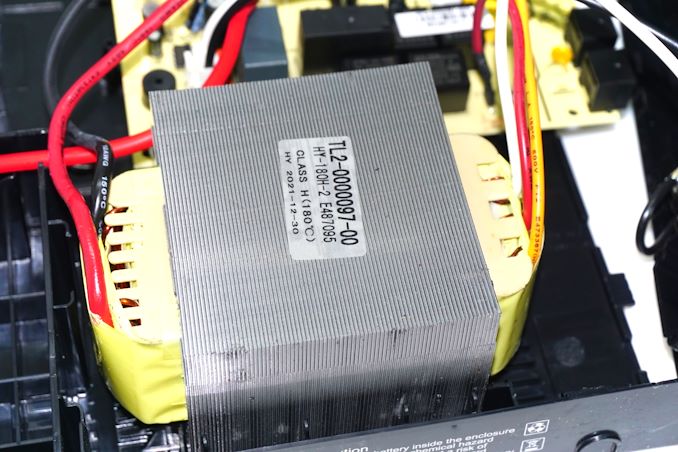








22 Comments
View All Comments
ballsystemlord - Friday, October 28, 2022 - link
Well, I don't think that should be called a sine wave -- modified or not.DanNeely - Friday, October 28, 2022 - link
It's an industry term of art, it means "less awful than a pure square wave"; and while it doesn't have to be as bad is this one is generally translates to square wave with a degree of slope (from capacitor discharge?).jeromec - Friday, October 28, 2022 - link
I just purchased an even cheaper, LCDless CyberPower UPS (UT850EG-FR).A few remarks:
- it is natively recognized by macOS without installing CyberPower's software,
- the CyberPower software has a Mac version, that works on Ventura,
- the CyberPower software is not signed and insists on launching the app (and not only the daemon) at system start - it allows to setup "advanced" options such as muting alarms - I uninstalled it after setting them.
Samus - Friday, October 28, 2022 - link
APC in my opinion has superior UPS software to Cyber Power and Tripp Lite, though APC does not have a native MacOS version. However, much like Tripp Lite, you can use the native MacOS shutdown feature with any UPS. Simply configure the OS to shutdown or sleep when battery power reaches a set %. I usually set it to 50%However, Cyber Power in my opinion makes substantially better UPS's than Tripp Lite at the consumer end. Since Schneider bought APC a decade ago, I've noticed all the models since float charge the batteries too high. This shortens their life. A lot. I'd research it because while it seemed the situation was being rectified years ago, it wasn't, and their UPS's still do it. My Back-UPS XS 1000 float charges the lead-acid battery to 13.6v. Sealed lead acid (SLA) batteries can NOT be charged beyond 12V. They can't vent. This causes them to eventually swell and fail. They don't typically explode as they are low-density power and valve regulated (so when the valve pops - like a fuse, the battery internally cuts off input\output.)
I can't tell you how many APC Back-UPS products I've had to pry swollen SLA's out of to replace. Literally with a crow bar. Sometimes the case is even permanently deformed.
When you start spending $1000 for production units, or even $300-$500 for rack mount models, Cyber Power starts to lose some points compared to some APC products and many Tripp Lite products, but they are still overall competitive and I've rarely ever had a problem with them.
If I had a complaint about Cyber Power, it would be they are noisy. The coil whine from the charging\standby circuit is often noticeable in a quiet space. Their older products were not like this but all their new stuff has a buzz, hum, or occasional random noises.
Threska - Friday, October 28, 2022 - link
UPSs can be a mixed bag much like hard drives. Have an APC going strong for years. Another two of their backup variety down for the count. Also have a cyberpower that died.fmyhr - Monday, October 31, 2022 - link
I switched from APC to Eaton UPS for this very reason. Batteries last much longer. And very well supported in Linux. (I can't speak to MacOS support.)pjcamp - Friday, October 28, 2022 - link
In my experience, switching UPS's do not work. My neighborhood has a ton of momentary outages due to a large number of trees. I've spent a few thousand dollars total on various brand UPS's and have yet to find one that can deal with these. They just don't switch fast enough. I pulled the plug from the wall and by the time it switched (and I believe it was a Cyberpower), my computer was off. In fact, when I just stopped using them altogether, my computer on its own was able to ride out the momentary outages so in fact a switching UPS was worse than useless.Threska - Friday, October 28, 2022 - link
One could always get a delta-conversion online UPS.https://www.thomasnet.com/articles/electrical-powe...
Samus - Saturday, October 29, 2022 - link
That's very odd because the inherent design of a UPS is the load runs off the power conversion circuit regardless of live AC or not. When the power goes out, there should be no interruption because the load was already running off the battery before the power outage.Hence "uninterruptible." There should be no switch-over delay.
jeromec - Sunday, October 30, 2022 - link
There are 3 types of UPS:- online, in which the battery is always on - when AC power is available, a double conversion (AC to DC to AC) s performed,
- offline, where the battery is offline while AC power is available,
- online interactive, where the inverter is on while AC power is available.
For offline and online interactive types, there is a short amount of time required for switching, typically a few ms. This power break is absorbed by the devices behind the UPS.